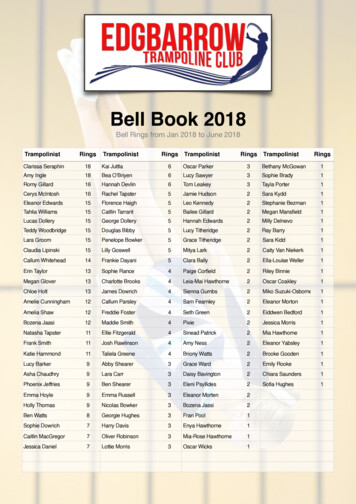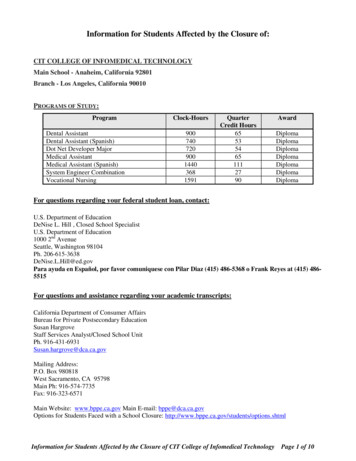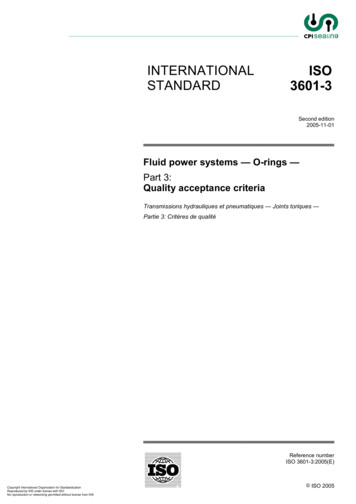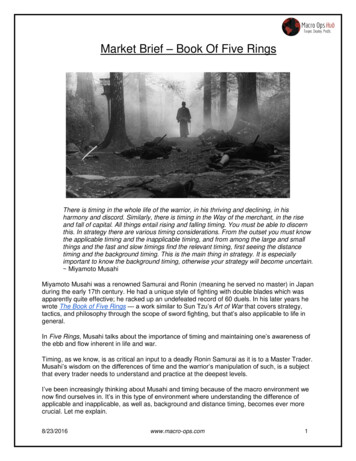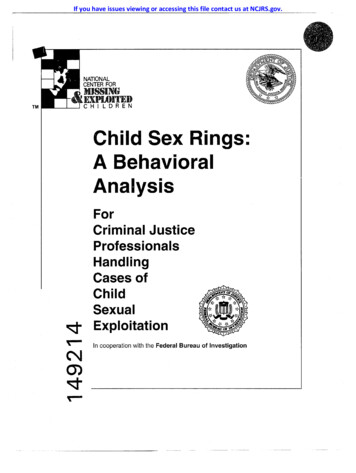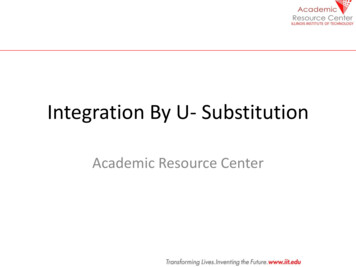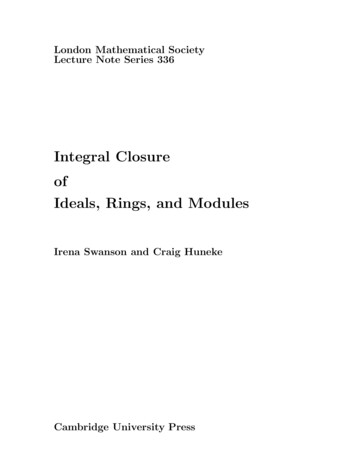
Transcription
London Mathematical SocietyLecture Note Series 336Integral ClosureofIdeals, Rings, and ModulesIrena Swanson and Craig HunekeCambridge University Press
London Mathematical Society Lecture Note Series 336Integral Closure of Ideals,Rings, and ModulesCraig HunekeUniversity of KansasIrena SwansonReed College, PortlandCambridge University Press
ContentsContentsTable of basic propertiesNotation and basic definitionsPreface1. What is integral closure of ideals?1.1. Basic properties1.2. Integral closure via reductions1.3. Integral closure of an ideal is an ideal1.4. Monomial ideals1.5. Integral closure of rings1.6. How integral closure arises1.7. Dedekind–Mertens formula1.8. Exercises2. Integral closure of rings2.1. Basic facts2.2. Lying-Over, Incomparability, Going-Up, Going-Down2.3. Integral closure and grading2.4. Rings of homomorphisms of ideals2.5. Exercises3. Separability3.1. Algebraic separability3.2. General separability3.3. Relative algebraic closure3.4. Exercises4. Noetherian rings4.1. Principal ideals4.2. Normalization theorems4.3. Complete rings4.4. Jacobian ideals4.5. Serre’s conditions4.6. Affine and Z-algebras4.7. Absolute integral closure4.8. Finite Lying-Over and height4.9. Dimension one4.10. Krull domains4.11. Exercises5. Rees algebras5.1. Rees algebra constructions5.2. Integral closure of Rees algebras5.3. Integral closure of powers of an 959606366737680828689939999101103
vi5.4. Powers and formal equidimensionality5.5. Defining equations of Rees algebras5.6. Blowing up5.7. Exercises6. Valuations6.1. Valuations6.2. Value groups and valuation rings6.3. More properties of valuation rings6.4. Existence of valuation rings6.5. Valuation rings and completion6.6. Some invariants6.7. Examples of valuations6.8. Valuations and the integral closure of ideals6.9. The asymptotic Samuel function6.10. Exercises7. Derivations7.1. Analytic approach7.2. Derivations and differentials7.3. Exercises8. Reductions8.1. Basic properties and examples8.2. Connections with Rees algebras8.3. Minimal reductions8.4. Reducing to infinite residue fields8.5. Superficial elements8.6. Superficial sequences and reductions8.7. Non-local rings8.8. Sally’s theorem on extensions8.9. Exercises9. Analytically unramified rings9.1. Rees’s characterization9.2. Module-finite integral closures9.3. Divisorial valuations9.4. Exercises10. Rees valuations10.1. Uniqueness of Rees valuations10.2. A construction of Rees valuations10.3. Examples10.4. Properties of Rees valuations10.5. Rational powers of ideals10.6. Exercises11. Multiplicity and integral closure11.1. Hilbert–Samuel polynomials11.2. 85186188190193195195199204209213216221221226
vii12.13.14.15.16.17.11.3. Rees’s theorem11.4. Equimultiple families of ideals11.5. ExercisesThe conductor12.1. A classical formula12.2. One-dimensional rings12.3. The Lipman–Sathaye theorem12.4. ExercisesThe Briançon–Skoda Theorem13.1. Tight closure13.2. Briançon–Skoda via tight closure13.3. The Lipman–Sathaye version13.4. General version13.5. ExercisesTwo-dimensional regular local rings14.1. Full ideals14.2. Quadratic transformations14.3. The transform of an ideal14.4. Zariski’s theorems14.5. A formula of Hoskin and Deligne14.6. Simple integrally closed ideals14.7. ExercisesComputing integral closure15.1. Method of Stolzenberg15.2. Some computations15.3. General algorithms15.4. Monomial ideals15.5. ExercisesIntegral dependence of modules16.1. Definitions16.2. Using symmetric algebras16.3. Using exterior algebras16.4. Properties of integral closure of modules16.5. Buchsbaum–Rim multiplicity16.6. Height sensitivity of Koszul complexes16.7. Absolute integral closures16.8. Complexes acyclic up to integral closure16.9. ExercisesJoint reductions17.1. Definition of joint reductions17.2. Superficial elements17.3. Existence of joint reductions17.4. Mixed multiplicities17.5. More manipulations of mixed 5315317320322326332334338340345345347349352358
viii17.6. Converse of Rees’s multiplicity theorem17.7. Minkowski inequality17.8. The Rees–Sally formulation and the core17.9. Exercises18. Adjoints of ideals18.1. Basic facts about adjoints18.2. Adjoints and the Briançon–Skoda Theorem18.3. Background for computation of adjoints18.4. Adjoints of monomial ideals18.5. Adjoints in two-dimensional regular rings18.6. Mapping cones18.7. Analogs of adjoint ideals18.8. Exercises19. Normal homomorphisms19.1. Normal homomorphisms19.2. Locally analytically unramified rings19.3. Inductive limits of normal rings19.4. Base change and normal rings19.5. Integral closure and normal maps19.6. ExercisesAppendix A. Some background materialA.1. Some forms of Prime AvoidanceA.2. Carathéodory’s theoremA.3. GradingA.4. ComplexesA.5. Macaulay representation of numbersAppendix B. Height and dimension formulasB.1. Going-Down, Lying-Over, flatnessB.2. Dimension and height inequalitiesB.3. Dimension formulaB.4. Formal equidimensionalityB.5. Dimension 412412413414416418421439
Table of basic propertiesIn this table, R is an arbitrary Noetherian ring, and I, J ideals in R. Theoverlinesdenote the integral closure in the ambient ring.(1) I I (2)(3)(4)(5)(6)(7)(8)(9)(10)(11)(12)(13)(14)(15) I and 0 I. (Page 2.)I I. (Corollary 1.3.1.)Whenever I J, then I J . (Page 2.)For any I, J, I : J I : J. (Page 7.)For any finitely generated non-zero I and any J in a domain,IJ : I J. (Corollary 6.8.7.)An intersection of integrally closed ideals is an integrally closedideal. (Corollary 1.3.1.)ϕPersistence: if R S is a ring homomorphism, then ϕ(I) ϕ(I)S. (Page 2.)If W is a multiplicatively closed set in R, then IW 1 R IW 1 R. (Proposition 1.1.4.)An element r R is in the integral closure of I if and only iffor every minimal prime ideal P in R, the image of r in R/Pis in the integral closure of (I P )/P . (Proposition 1.1.5.)Reduction criterion: J I if and only if there exists l N 0 such that (I J)l I (I J)l 1 . (Corollary 1.2.5.)Valuative criterion: J I if and only if for every (Noetherian) valuation domain V which is an R-algebra, JV IV .When R is an integral domain, the V need only vary over valuation domains in the field of fractions of R. Furthermore, theV need only vary over valuation domains centered on maximalideals. (Theorem 6.8.3 and Proposition 6.8.4.)I · J IJ. (Remark 1.3.2 (4), or Corollary 6.8.6.)Let R S be an integral extension of rings. Then IS R I.(Proposition 1.6.1.)If S is a faithfully flat R-algebra, then IS R I. (Proposition 1.6.2.)The integral closure of a Zn Nm -graded ideal is Zn Nm graded. (Corollary 5.2.3.)
x(16) If R is a polynomial ring over a field and I is a monomialideal, then I is also a monomial ideal. The monomials in I areexactly those for which the exponent vectors lie in the Newtonpolyhedron of I. (Proposition 1.4.6, more general version inTheorem 18.4.2.)(17) Let R be the ring of convergent power series in d variablesX1 , . . . , Xd over C, or a formal power series ring in X1 , . . . , Xdover field of characteristic zero. If f R with f (0) 0, then f ff X1, . . . , Xd. X1 Xd(18)(19)(20)(21)(22)(23)(Corollary 7.1.4 and Theorem 7.1.5.)Let (R, m) be a Noetherian local ring which is not regular andI an ideal of finite projective dimension. Then m(I : m) mIand I : m is integral over I. (Proposition 1.6.5.)x I if and only if there exists c R not in any minimalprime ideal such that for all sufficiently large n, cxn I n .(Corollary 6.8.12.)If R is a Noetherian local ring, then ht(I) ℓ(I) dim R.(Corollary 8.3.9. The notation ℓ() stands for analytic spread.)If R is local with infinite residue field, then I has a minimalreduction, and every minimal reduction of I is generated byℓ(I) elements. (Proposition 8.3.7.)If I or J is not nilpotent, then ℓ(IJ) ℓ(I) ℓ(J). (Proposition 8.4.4.)x I n if and only iflimi ordI (xi ) n.i(Corollary 6.9.1 and Lemma 6.9.2.)(24) If R S is a normal ring homomorphism of Noetherian rings,then for any ideal I in R, IS IS. (Corollary 19.5.2.)
Notation and basic definitionsExcept where otherwise noted, all rings in this book are commutative withidentity and most are Noetherian. An ideal in a ring R generated by a1 , . . . , anis denoted by (a1 , . . . , an ) or (a1 , . . . , an )R. If n 1, it is also written as a1 R.A ring is local if it has only one maximal ideal. We write (R, m) to denotea local ring with maximal ideal m, and (R, m, k) to denote (R, m) with residuefield k. An overring S of R is a ring that contains R as a subring. AnR-algebra S is essentially of finite type over R if S is a localization of afinitely generated R-algebra. The total ring of fractions is the localizationof R inverting all non-zerodivisors. If f : R S is a ring homomorphism, Ian ideal in R and J an ideal in S, then IS is the ideal in S generated by f (I);and J R is the ideal f 1 (J).An R-module M is faithful if ann(M ) 0. M is torsion-free if for anynon-zerodivisor r of R and any m M , rm 0 implies that m 0. If I is anideal in R, M is said to be separated in the I-adic topology if n I n M 0.A\BNmRMin(R)Max(R)Ass(M )RoRredbRR(X)Q(R)ωRdim( )λ( )T (R), Tk (R)(Ri ), (Si )JS/RK KR I, Rtr.degF (K)[K : F ]TreD(R), D(R)set difference A minus Bnatural numbers starting from 0the maximal ideal of a local ring Rthe set of minimal prime ideals of Rthe set of maximal prime ideals of Rset ofS associated prime ideals of MR \ P Min(R) Pring R modulo its nilradicalcompletion of (R, m) in the m-adic topologyfaithfully flat extension of R, Section 8.4field of fractions of Rcanonical module of RKrull dimension; vector-space dimensionlengthDefinition 13.4.3Serre’s conditions, Definition 4.5.1Jacobian ideal, Definition 4.4.1the set of units in Kalgebraic closure of fieldabsolute integral closure, Section 4.7integral closure of ideal, ringtranscendence degree of K over FF -vector space dimension of a field Ktraceset of divisorial valuation (ring)s with respectto R, Definition 9.3.1, Section 18.1 resp.
xiiRvmvκvrk(v), rat.rk(v)ΓvΓVR[It], R[It, t 1 ]grI (R)FI (R), FIκ(P )adj( )ann( )depth() IV (I)ht( )ℓ( )µ( )ordI ( )the valuation ring of valuation v, Section 6.2the maximal ideal of Rvthe residue field of Rvrank and rational rank of v, Definition 6.6.1value group of valuation v, Definition 6.2.1,value group of valuation ring V , page 122Rees and extended Rees algebras, Chapter 5associated graded ring, Definition 5.1.5fiber cone of I, Definition 5.1.5field of fractions of R/P , residue field of Padjoint, Chapter 18annihilator idealdepth of a module or ring, depth(R) radical of Ithe set of prime ideals in R containing Iheight of an ideal, ht(R) analytic spread, Definition 5.1.5minimal number of generatorsorder function, Definition 6.7.7,ordR ( ) ordm( ) if (R, m) is a local ringc(I)content of an ideal, 14.1.1c(f )content of a polynomial, 1.7.1RV ( )set of Rees valuations or Rees valuation rings 1IHomR (I, R), Definition 2.4.50 1 2I , I , I , etc.R (powers of an ideal I in a ring R)I Jideal I dividesS idealn J, Definition 14.0.1 I:Jthe union n (I : J ), where I and J are idealsrJ (I)reduction number, Definition 8.2.3rk(M )rank of a moduleif R domain: rk M dimQ(R) (M R Q(R))eR (I; M ), e(I; M ), e(R) multiplicity, Chapter 11eR (I1 , . . . , Id ; M ),[d ][d ]eR (I1 1 , . . . , Ik k ; M ) mixed multiplicity, Chapter 17PI,M (n)Hilbert–Samuel polynomialdetf (M )determinant of a module, Proposition 16.3.2It (ϕ)ideal of t t minors of a matrix ϕER (M )page 321RF (M )a Rees algebra of a module, Definition 16.2.1SF (M )Definition 16.2.1SymR (M )symmetric algebra of M , Chapter 16T Rinfinitely near, Definition 14.5.1vIasymptotic Samuel function, Definition 6.9.3 (v)Lipman’s reciprocity, 14.6.2
PrefaceIntegral closure has played a role in number theory and algebraic geometrysince the nineteenth century, and a modern formulation of the concept for ideals perhaps began with the work of Krull and Zariski in the 1930s. This bookis on the integral closure of ideals, rings, and modules over commutative Noetherian rings with identity. Our goal in writing this book was to collect material scattered through many papers, and to present it with a unified treatment.To make the book self-contained, we begin with basic material, and developmost of what is needed to read the book. We hope the presentation makesthe book friendly to a beginner. The reader should have basic knowledge ofcommutative algebra, such as modules, Noetherian chain conditions, primeideals, polynomial rings, Krull dimension, height, primary decompositions,regular sequences, homomorphisms, regular and Cohen–Macaulay rings, andthe process of completion. One exception is the need to have prior knowledgeof the integral closure of rings, as this is worked out carefully in Chapter 2.Integral closures of ideals, rings and modules overlap many important topics, including the core of ideals, Hilbert functions, homological algebra, multiplicities (mixed and otherwise), singularity theory, the theory of Rees algebras, resolution of singularities, tight closure, and valuation theory. While allof these topics are touched on in the book, we ask the reader to forgive us ifwe didn’t fully explore their own favorite from among this list. After over 425pages, we had to put some limits on what we could cover.The book is written to be read in linear order. The first eleven chaptersare linearly dependent upon each other to some extent, but the last severalchapters are largely independent of each other, and the reader or instructorcan easily pick and choose which they prefer to cover. In a few places in laterchapters more commutative algebra techniques are used without backgroundexplanation. Exercises are included at the end of each chapter. Some exercisesare easier than others; exercises labelled with a star are hard.A seminar, beginning in 1984, with William Heinzer, Sam Huckaba, JeeHub Koh, Bernard Johnston, and Jugal Verma, and later Judith Sally, wasinstrumental in encouraging the second author’s interest in this material. Thesubject of the seminar, integral closure, became the basis of courses given bythe second author at Purdue University. An impetus in writing the book wasprovided by a grant to the first author from the NSF POWRE program thatenabled us to work together during 2000/01 at the University of Kansas. Thefirst author taught there from the very first version of the book. We thank thestudents in that course for helping us smooth the presentation: Giulio Caviglia, Cătălin Ciupercă, Bahman Engheta, Glenn Rice, Janet Striuli, EmanoilTheodorescu, and Yongwei Yao. Yongwei Yao provided several results andexercises for the book.
xivMarie Vitulli taught from a second preliminary version at the Universityof Oregon. We thank Marie Vitulli for her support and feedback, and toAaron Tresham for working out solutions to the exercises. Several peopleread parts of earlier versions of the book and provided valuable feedback onthe content and on the presentation: Lionel Alberti, Jean Chan, AlbertoCorso, Dale Cutkosky, Clare D’Cruz, Trung Dinh, Neil Epstein, Sara Faridi,Terence Gaffney, Daniel Grayson, William Heinzer, Melvin Hochster, Reinhold Hübl, Eero Hyry, Mark Johnson, Olga Kashcheyeva, Daniel Katz, FranzViktor Kuhlmann, Monique Lejeune-Jalabert, Joseph Lipman, Thomas Marley, Stephen McAdam, Patrick Morandi, Liam O’Carroll, Bruce Olberding,Greg Piepmeyer, Claudia Polini, Christel Rotthaus, Mark Spivakovsky, Branden Stone, Steven Swanson, Amelia Taylor, Bernd Ulrich, Wolmer Vasconcelos, Janet Vassilev, Jugal Verma, and Cornelia Yuen. We are indebted to allfor improving the book and for reducing the number of errors. Of course, theremaining errors are all our own. Terence Gaffney and Joseph Lipman introduced us to material that we had not previously considered, and we thankthem for their help.William Heinzer, Liam O’Carroll, Claudia Polini, Christel Rotthaus, AmeliaTaylor, Bernd Ulrich, and Jugal Verma gave us crucial detailed comments thathelped us clarify the presentation. Daniel Katz went beyond any call of interest or friendship; he read and corrected the whole book, and often suggestedclearer and better proofs. We thank them profusely.We gratefully acknowledge the partial support of NSF while the book wasin progress; the second author was supported in part by NSF grant 024405,while the first author acknowledges support on NSF grants 9970566, 0200420,on the POWRE NSF grant 0073140, and on the ADVANCE InstitutionalTransformation Program at New Mexico State University, fund NSF0123690,during Spring 2005.We thank Cambridge University Press, and in particular Roger Astley, forencouragement and help over the years it took us to write this book.The book was typeset with TEX, and the few pictures were made withTimothy van Zandt’s pstricks. Occasionally, to explain some side remarkor a well-known point, we use the small-print paragraphs.Our families put up with us over our years of effort on this book, even whenthings were not working as we hoped. Nothing works without family support,and our heartfelt gratitude go to Steve, Simon, Edie, Sam, and Ned.Ultimately, our thanks go to the many researchers who developed integralclosure; we ourselves owe a special debt to Joseph Lipman and David Rees,who inspired and taught us, and this book is dedicated to both of them.
1What is integral closure of ideals?The main goal of this chapter is to introduce the integral closure of ideals.We give basic definitions, show some elementary manipulations, give a flavorof the theory for monomial ideals, and show how integral closure arises invarious contexts.Why and how did the integral closure of ideals arise in the first place? Muchof commutative algebra is dependent, in various guises, upon understandinggrowth of ideals. A classic example of this phenomenon is the Hilbert–Samuelpolynomial for an m-primary ideal I in a local Noetherian ring (R, m). Forlarge n, the length of R/I n , as a function of n, equals an integer-valuedpolynomial. The coefficients of this polynomial are necessarily rational, andare numerical invariants which are important for study of the pair (R, I). Forexample, the degree of this polynomial equals d dim R, and the normalizedleading coefficient of the polynomial, namely the leading coefficient times d!,is an invariant carrying much information about I and even about R. It iscalled the multiplicity of I on R (which is the multiplicity of R if I m). Akey question is what elements r can be added to an m-primary ideal I so thatI and I rR exhibit the same power-growth, or more specifically, have thesame multiplicity?A first try might be to say that “powers of r grow as powers of I”, i.e., ifthere is an n such that r n I n . This has merit, but allows too few elements r.A next attempt can be an asymptotic version. Let vn (r) be the least powerof r in I n . If the limit of vnn(r) exists and is at least 1, we can intuitively thinkthat r “grows” at least as fast as I. This approach was taken by David Reesin the 1950s, and successfully picks elements r.Another approach is to use valuations to measure the relative “sizes” of Iand r. One can simply require that v(r) v(I) for every valuation v. This apriori leads to a new and different idea of growth, but it turns out to be thesame as Rees’s asymptotic approach above.There are other natural approaches. One approach that has become moreimportant through its relationship to tight closure is to ask that there be anelement c such that for all large n, cr n I n . Taking nth roots and letting ngo to infinity somehow captures the sense that r is almost in I.All of these different approaches lead to the same concept, which is calledthe integral closure of the ideal I. Moreover, integral closure occurs naturallyin many contexts. Even more remarkably, all of these notions can be subsumedinto a single equational definition (see Section 1.1).The goal of this chapter is to introduce the integral closure of ideals, showsome elementary manipulations, and motivate the study of integral closure.
21. What is integral closure of ideals?We present many examples of integral closure constructions. In Section 1.4we illustrate the theory on monomial ideals. In the last two sections wedescribe how integral closure arises naturally in many contexts. We start withthe equational definition, and in Section 1.2 we characterize integral closurewith reductions. We expand more on the theory of reductions in Chapter 8.The valuative approach to integral closure is taken up in Chapter 6, Rees’sasymptotic approach is in Chapter 10, and the connection with the Hilbert–Samuel polynomial and multiplicity is in Chapter 11.1.1. Basic propertiesDefinition 1.1.1 Let I be an ideal in a ring R. An element r R is said to beintegral over I if there exist an integer n and elements ai I i , i 1, . . . , n,such thatr n a1 r n 1 a2 r n 2 · · · an 1 r an 0.Such an equation is called an equation of integral dependence of r over I(of degree n).The set of all elements that are integral over I is called the integral closure of I, and is denoted I. If I I, then I is called integrally closed. IfI J are ideals, we say that J is integral over I if J I.If I is an ideal such that for all positive integers n, I n is integrally closed,then I is called a normal ideal.A basic example is the following:Example 1.1.2 For arbitrary elements x and y R, xy is in the integralclosure (x2 , y 2 ) of the ideal (x2 , y 2 ). Namely, with n 2, a1 0 (x2 , y 2 )and a2 x2 y 2 (x2 , y 2 )2 , (xy)2 a1 (xy) a2 0 is an equation of integraldependence of xy over (x2 , y 2 ).Similarly, for any non-negative integer i d, xi y d i is in (xd , y d ).Remark 1.1.3(1) I I, as for each r I, n 1 and a1 r give an equation of integraldependence of r over I.(2) If I J are ideals, then I J, as every equation of integral dependenceof r over I is also an equation of integral dependence of r over J.(3) I I, as from the equation of integral dependence of r over I of degreen as above, r n (a1 , . . . , an ) I.(4) Radical, hence prime, ideals are integrally closed.(5) The nilradical 0 of the ring is contained in I for every ideal I becausefor each nilpotent element r there exists an integer n such that r n 0,and this is an equation of integral dependence of r over I.(6) Intersections of integrally closed ideals are integrally closed.ϕ(7) The following property is called persistence: if R S is a ring homomorphism, then ϕ(I) ϕ(I)S. This follows as by applying ϕ to an
1.1. Basic properties3equation of integral dependence of an element r over I to obtain an equation of integral dependence of ϕ(r) over ϕ(I)S.ϕ(8) Another important property is contraction: if R S is a ring homomorphism and I an integrally closed ideal of S, then ϕ 1 (I) is integrallyclosed in R. Namely, if r is integral over ϕ 1 (I), then applying ϕ to anequation of integral dependence of r over ϕ 1 (I) gives an equation ofintegral dependence of ϕ(r) over I, so that ϕ(r) I, whence r ϕ 1 (I).(9) In particular, if R is a subring of S, and I an integrally closed ideal of S,then I R is an integrally closed ideal in R.Integral closure behaves well under localization:Proposition 1.1.4 Let R be a ring and I an ideal in R. For any multiplicatively closed subset W of R, W 1 I W 1 I.Furthermore, the following are equivalent:(1) I I.(2) For all multiplicatively closed subsets W of R, W 1 I W 1 I.(3) For all prime ideals P of R, IP IP .(4) For all maximal ideals M of R, IM IM .Proof: By persistence of integral closure, W 1 I W 1 I IW 1 R. Letr W 1 I. Write r n a1 r n 1 · · · an 0 for some positive integer nand some ai W 1 I i . There exists w W such that wr R and for alli 1, . . . , n, wai I i . Multiplying the integral equation by wn yields(wr)n a1 w(wr)n 1 · · · an 1 wn 1 (wr) an wn 0.All the summands are in R, but the equality holds in W 1 R. Multiplyingthrough by the nth power of some w′ W gives equality in R:(ww′ r)n a1 ww′ (ww′ r)n 1 · · · an 1 (ww′ )n 1 (ww′ r) an (ww′ )n 0.This is an integral equation of ww′ r R over I. Thus r W 1 I, whichproves the first part.By the first part, (1) implies (2), and clearly (2) implies (3) and (3) implies(4). Now assume that (4) holds. Let r I. Then for all maximal idealsM in R, r IM , hence r I. This proves (1) and finishes the proof of theproposition.The following proposition reduces questions about of integral closure toquestions about integral closure in integral domains:Proposition 1.1.5 Let R be a ring, not necessarily Noetherian. Let I be anideal in R.(1) The image of the integral closure of I in Rred is the integral closure ofthe image of I in Rred : IRred IRred . Thus I equals the natural lift toR of the integral closure of I in the reduced ring Rred .(2) An element r R is in the integral closure of I if and only if for everyminimal prime ideal P in R, the image of r in R/P is in the integralclosure of (I P )/P .
41. What is integral closure of ideals?Proof: By persistence of integral closure, IR red is contained in IRred . Forthe other inclusion, let r R such that r 0 IRred . Write f r n a1 r n 1 · · · an 1 r an 0 for some ai I i . Some power of f is zero.But f k 0 gives an equation of integral dependence of r over I of degree kn,which finishes the proof of (1).We prove (2). By persistence of integral closure, the image of I in R/P iscontained in the integral closure of (I P )/P for every P . Conversely, let Wbe the set {r n a1 r n 1 · · · an n N 0 , ai I i }. Note that W is a subsetof R that is closed under multiplication. If W contains 0, r is integral over I;otherwise there is a prime ideal Q in R disjoint from W . As minimal primeideals exist in every ring R, there is a minimal prime ideal P contained in Q.By assumption on Q, W P W Q , but by the assumption on all theminimal prime ideals, W P is not empty, contradicting the assumption that0 is not in W .When the set of minimal prime ideals of R is finite, an equation of integraldependence of r over I can be constructed from the equations of integraldependence of r over I modulo each of the minimal prime ideals P1 , . . . , Pmas follows: there exist aji I i , i 1, . . . , nj , such that f j r nj aj1 r nj 1 · · · aj,nj 1 r aj,nj Pj . Then f f1 f2 · · · fm 0, so that for somepositive integer k, f k 0, and this gives an equation of integral dependenceof r over I.Remark 1.1.6 Even if there are finitely many minimal prime ideals and theideal I is contained in none of them, it may happen that the integral closureof I is determined by going modulo only a proper subset of the minimal primeideals. For example, let R k[X, Y, Z]/(XY ), with X, Y, Z variables over k.For I (Y, Z)R, the integral closure of I modulo the minimal prime ideal(X) lifts to (X, Y, Z)R and the integral closure of I modulo the minimal prime(Y ) lifts to (Y, Z)R, making the first calculation redundant.We next rephrase integral closure with ideal equalities:Proposition 1.1.7 Let R be a ring, not necessarily Noetherian. For anyelement r R and ideal I R, r I if and only if there exists an integer nsuch that (I (r))n I(I (r))n 1 .Proof: First suppose that r I. Then an equation of integral dependence ofr over I of degree n shows that r n I(I (r))n 1 and hence that (I (r))n I(I (r))n 1 . Conversely, if (I (r))n I(I (r))n 1 then r n b1 r n 1 b2 r n 2 · · · bn 1 r bn for some bi I i , which can be easily rewritten intoan equation of integral dependence of r over I.One can also use modules to express integral dependence:Corollary 1.1.8 (Determinantal trick, cf. Lemma 2.1.8) Let I be an idealin R and r R. Then the following are equivalent:
1.2. Integral closure via reductions5(1) r is integral over I.(2) There exists a finitely generated R-module M such that rM IM andsuch that whenever aM 0 for some a R, then r 0 : a.Moreover, if I is finitely generated and contains a non-zerodivisor, r is integralover I if and only if there exists a finitely generated faithful R-module M suchthat IM (I (r))M .Proof: Let r n a1 r n 1 · · · an 0 be an equation of integral dependence ofr over I. There exists a finitely generated ideal J I such that ai J i for alli 1, . . . , n. Thus r is integral over J, and by Proposition 1.1.7, there existsan integer n such that J(J (r))n 1 (J (r))n . Then M (J (r))n 1 isfinitely generated, and rM r(J (r))n 1 (J (r))n J(J (r))n 1 JM IM . Also, if aM 0, then ar n 1 0.When I is finitely generated, we may take J I, so that IM (I (r))M .If I contains a non-zerodivisor, M is faithful.Conversely, assume (2). Let M Rb1 · · · Rbm beR-module suchPanmthat rM IM . For each i 1, . . . , m, write rbi j 1 aij bj for someaij I. Let A be the matrix (δij r aij ), where δij is the Kronecker deltafunction. Let b be the vector (b1 , . . . , bm )T . By construction Ab 0, so thatdet(A)b adj(A)Ab 0. Hence for all i, det(A)bi 0, so that det(A)M 0. By assumption det(A)r k 0 for some integer k, and an expansion ofdet(A)r k 0 yields an equation of integral dependence of r over I. The laststatement now also follows.The first case of Proposition 1.1.7, for special rings, without using the term“integral”, is in Prüfer’s 1932 paper [226], on pages 14–16. In the same paper,Prüfer used the determinantal trick as in the proof above.1.2. Integral closure via reductionsWe introduce reductions in this section. Reductions are an extre
5.4. Powers and formal equidimensionality 106 5.5. Defining equations of Rees algebras 110 5.6. Blowing up 114 5.7. Exercises 115 6. Valuations 119 6.1. Valuations 119 6.2. Value groups and valuation rings 121 6.3. More properties of valuation rings 123 6.4. Existence of valuation rings 126 6.5. Valuatio
